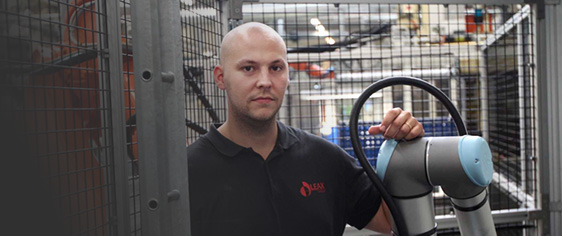Conquer manufacturing in the COVID-19 era with collaborative robots
Plant closures. Partial Layoffs. Staggered shifts. Labor shortages. Stringent hygiene measures. Restrictions on the number of people working together at the same time.
These are just some of the ground realities of the new normal facing manufacturers operating in the COVID-19 era. As per the World Bank, by the end of 2018, India was the world's sixth-largest manufacturer. The labor-intensive manufacturing sector has been one of the hardest-hit due to the Coronavirus. According to Business Insider, the seasonally adjusted IHS Markit India Manufacturing Purchasing Managers Index (PMI), a reflection of the health of the manufacturing economy, fell to 27.4 in April, from 51.8 in March this year. Make no mistake; it is the sharpest deterioration in business conditions in the last 15 years.
There are two primary reasons for this negative direction - first, most manufacturing jobs are primarily on-site, and second, slowed economic activity has decreased demand. Manufacturing is one of the rare industries where work-from-home, Zoom meetings and teleconferencing can only accomplish so much. While job functions involving marketing, sales, management, finance, and R&D can work virtually, execution at the assembly line needs to start rolling out at specific physical locations and on time.
The main question arising in the mind of every forward-thinking manufacturing executive is how to adapt to this new normal. All isn't lost, and according to Forrester analytics, we are now entering the second stage of the pandemic, which requires us all to 'Adapt & Overcome.' Accordingly, the Indian government is taking efforts to gradually bring the economy back on track and has put forth a slew of requirements for work in this COVID-19 landscape. These steps include allowing industries outside municipalities and corporations to restart their operations, a renewed focus on domestic manufacturing, and tax exemptions for manufacturers. However, strict compliance to COVID-19 based on current lockdown and guidelines will have to be adhered to.
Automation to the Rescue
The mandatory guidelines include increased testing, following social distancing norms, and limiting the total number of workers at a physical location. These initiatives themselves give rise to a host of issues for manufacturing firms to tackle. Some of the automation barriers faced by manufacturing include an abundance of unskilled labor, a lack of space on the shop floor, or the lack of technical expertise to operate the complex new technology.
By using automation in their plants and assembly lines, manufacturers can overcome these issues. Cobots, in particular, are a niche automation solution which are the most efficient, flexible, and cost-effective way forward for factories looking to automate and reduce external dependence, especially to get on track to achieve ambitious Make in India plans.
This article introduces the undeniably important role of cobots in manufacturing and how they can easily adapt a new working model to improve output and efficiency, especially in the post-COVID-19 world.
What Are Cobots?
A cobot, short for collaborative robot, is a robot that is intended to physically interact or communicate with humans in a shared workspace. Built on the concept of Human Robot Collaboration, they are designed to work together with humans at the highest levels of truly collaborative applications, in any manufacturing environment.
In times of COVID-19, one of the key priorities for manufacturers is to protect their workforce with minimal loss in efficiency. Coronavirus is at its most lethal when it is allowed to spread through social contact. As a result, leading health advocates, including the World Health Organization (WHO) and eminent medical authorities in India have asked that strict social distancing norms be maintained, even when factories open up. The dependence on a migrant workforce in manufacturing belts across the country also needs to be mitigated.
Listed below are the major benefits and advantages of using cobots during the pandemic and beyond.
Social Distancing
By enabling humans and machines to work simultaneously, cobots reduce contact between human workers, allowing them to maintain safe social distancing standards. Manufacturers should allow social distancing practices in workplaces that are typically worker-dense (e.g., manufacturing plants, warehouses, etc.) by using cobots. This would allow factories to continue being productive while keeping employees safe. The lack of space on a typical factory floor forces workers to come within close physical proximity, which abets the spread of the infection.
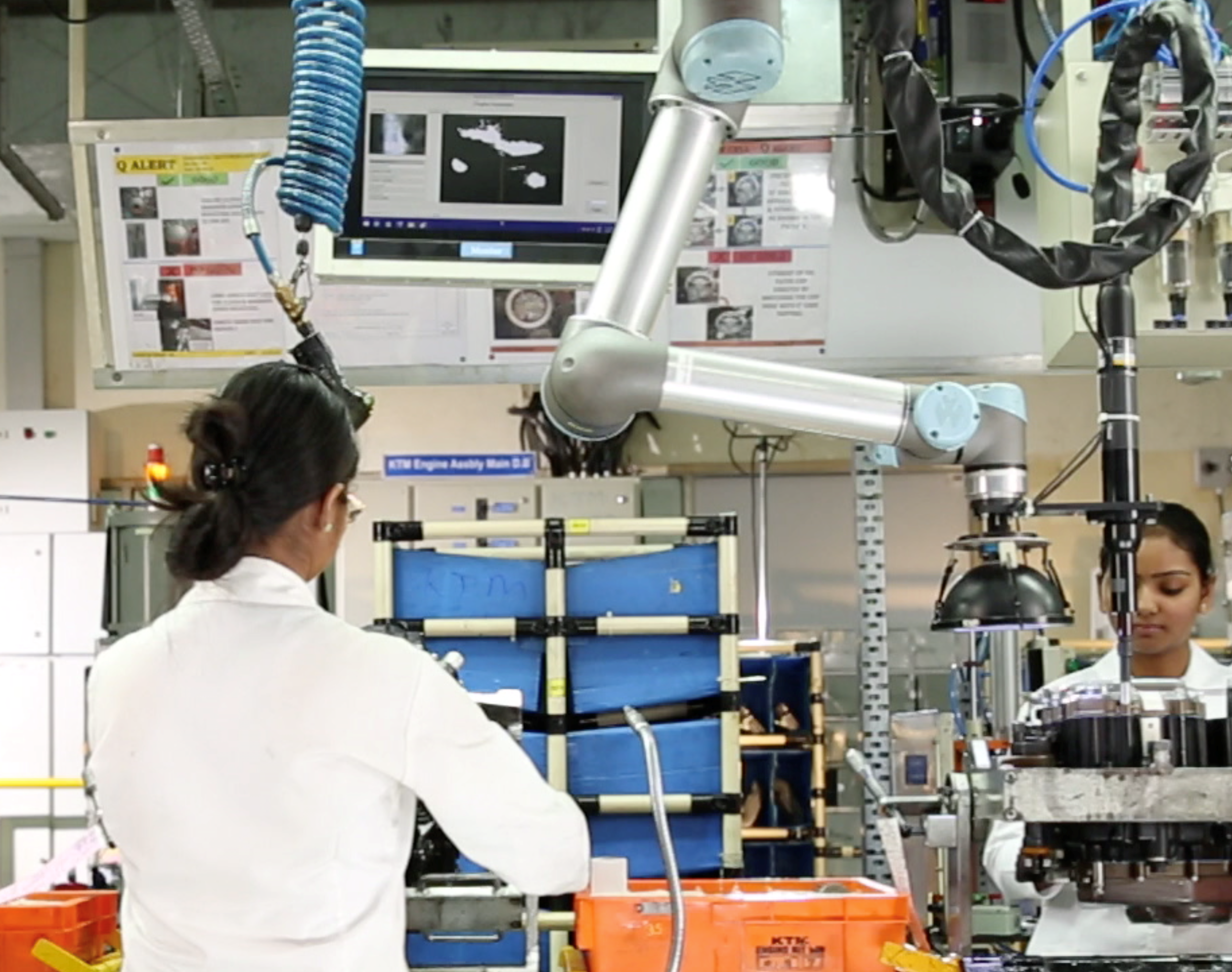 Cobots can be used in crowded assembly lines to enable social distancing on the shop floor
Cobots can be used in crowded assembly lines to enable social distancing on the shop floor
Additionally, an MIT Technology Review study found that there is an 85% reduction in idle time when humans and robots work together, which goes to show that cobots are not only safe but also effective in driving efficiency. Cobots are designed to be able to work safely with humans, without the need for caging or fencing (with subject to risk assessment). By using cobots in limited workspaces, factories can maintain the recommended distance between workers and increase safety, all while skyrocketing productivity and efficiency.
Partial Automation
It is well said in the manufacturing industry, "Automate what can be automated and simplify the rest." There are various levels of complexity in manufacturing. Different sub-segments of existing manufacturing facilities can be partially automated using cobots. By identifying specific applications or processes to deploy cobots, instead of the whole plant, manufacturers can reduce capital expenditure significantly.
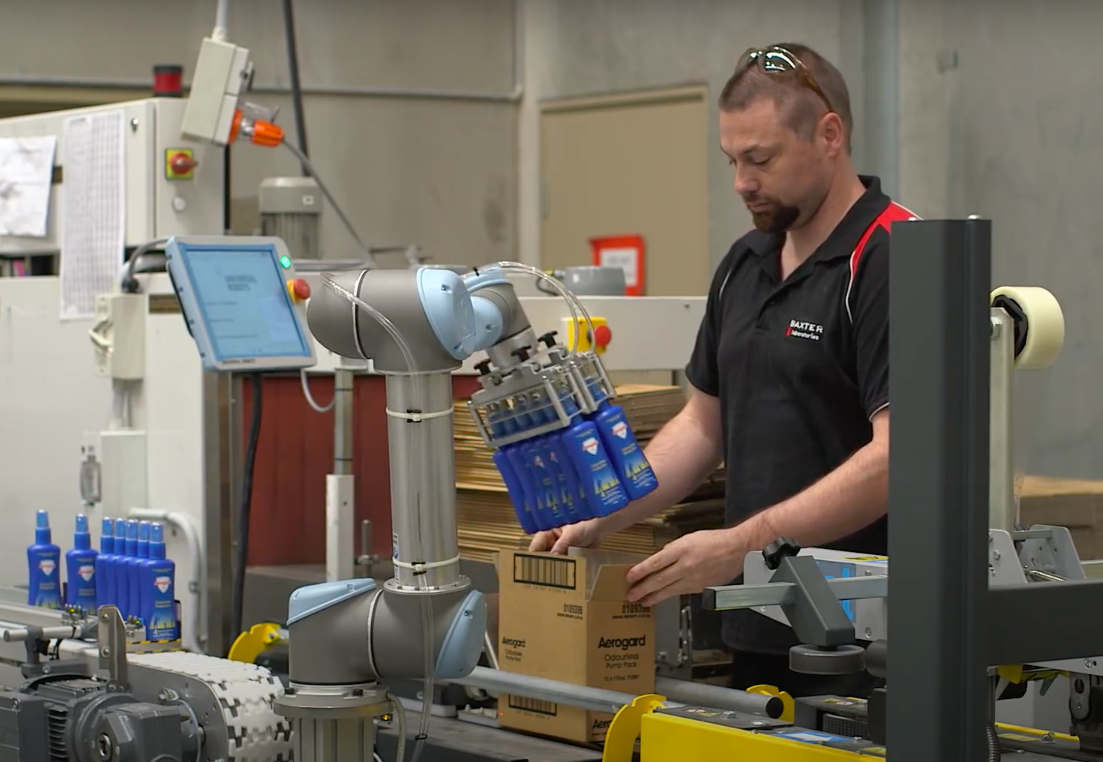 Partial automation at Baxter Lab, where an employee opens up boxes while a cobot places products into them
Partial automation at Baxter Lab, where an employee opens up boxes while a cobot places products into them
Manufactures can start small by deploying cobots only in processes requiring repeated human interaction, extra precision, or in operations which can be dangerous or monotonous. For example, at Baxter Lab, we can see that the cobots are placing bottles in boxes, but the man is manually holding the boxes open. Both are thus, working together and the process is only partially automated to optimize efficiency. Cobots bring safety, ergonomics, quality, and throughput - all crucial metrics for manufacturing management in an assembly plant.
Quick Deployment and Flexible Redeployment
Collaborative robots are one of the fastest automation solutions on the market to deploy and even redeploy for new applications, with setup often taking less than a day. In this uncertain environment, many manufacturers need to repurpose their assembly lines to focus on different products based on the urgency of requirements.
A key challenge is to be able to modify the assembly line to produce a larger number of units of products which have peaked in daily demands. The flexible redeployment of the cobots is an especially useful feature, as cobots are extremely easy to dismount and redeploy on different lines, depending upon the requirement. Traditional robots, in contrast, are often fixed installations, which are usually much too heavy and cumbersome to deploy and redeploy. Also, unskilled labor must be re-trained each time there is a small change in the assembly line, leading to cost and time over-runs.
A great example is how L'Oréal could shift cobots to different applications at the click of a button, allowing them to become more flexible and agile in terms of serving the market in real-time. Furthermore, the cobots could be easily reverted to the original assembly line, without affecting production output.
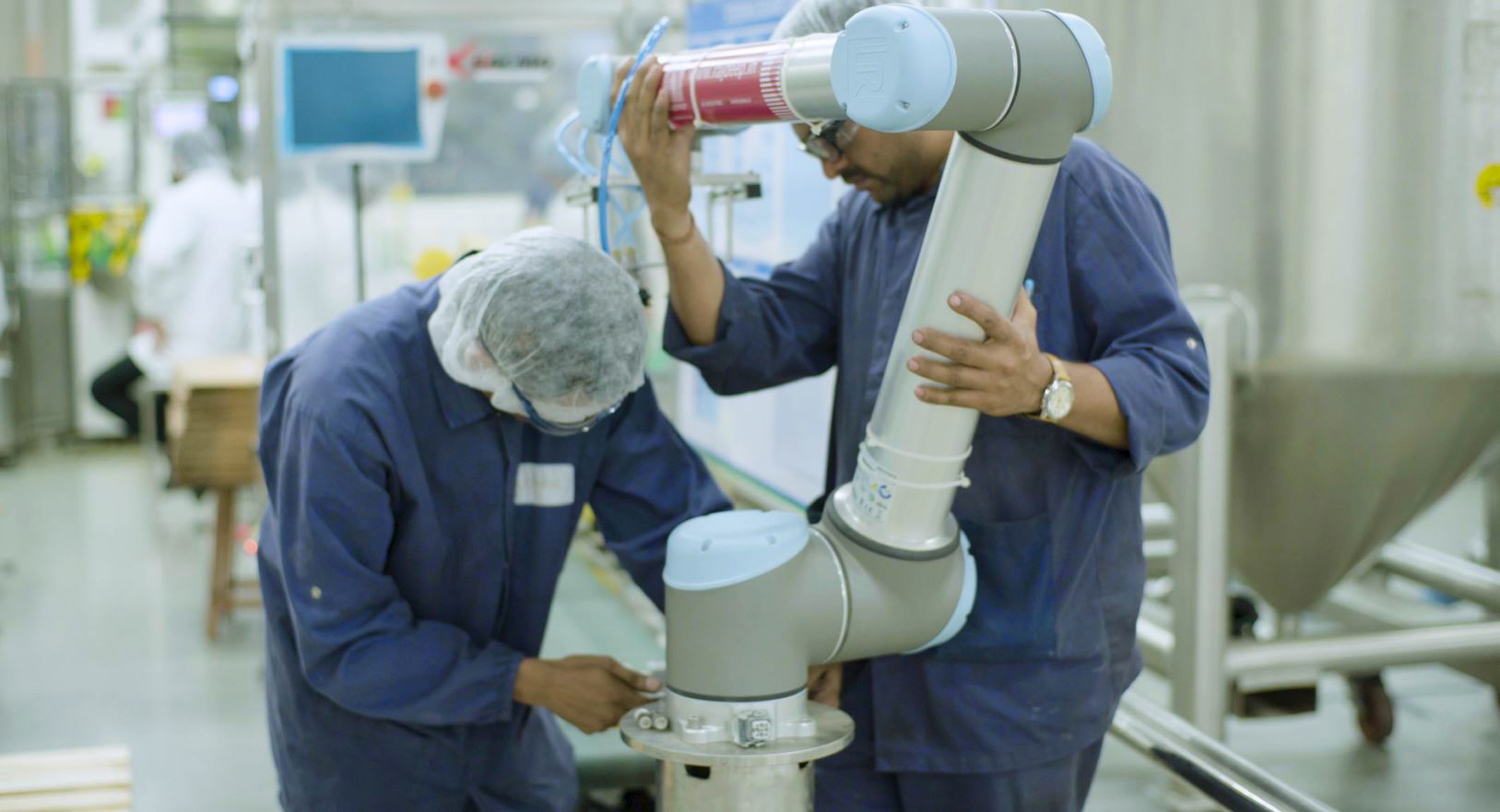 The L'Oréal team flexibly redeploys the cobot to different lines as and when needed
The L'Oréal team flexibly redeploys the cobot to different lines as and when needed
Cobots can be redeployed with ease for new applications. Repurposing assembly lines using cobots allows manufacturers to keep production lines up and running in times of low demand, switching easily to produce high demand products, generate revenues, and positively impact their reputation.
Democratized Automation
Cobots help bridge the gap between large and small manufacturers in the world of automation. The biggest challenge in the minds of manufacturers on deploying cobots is the perceived cost and technical difficulty of implementation. In truth, the sheer precision, cost-effectiveness, and competitiveness that cobots provide are unmatched in a globally competitive environment.
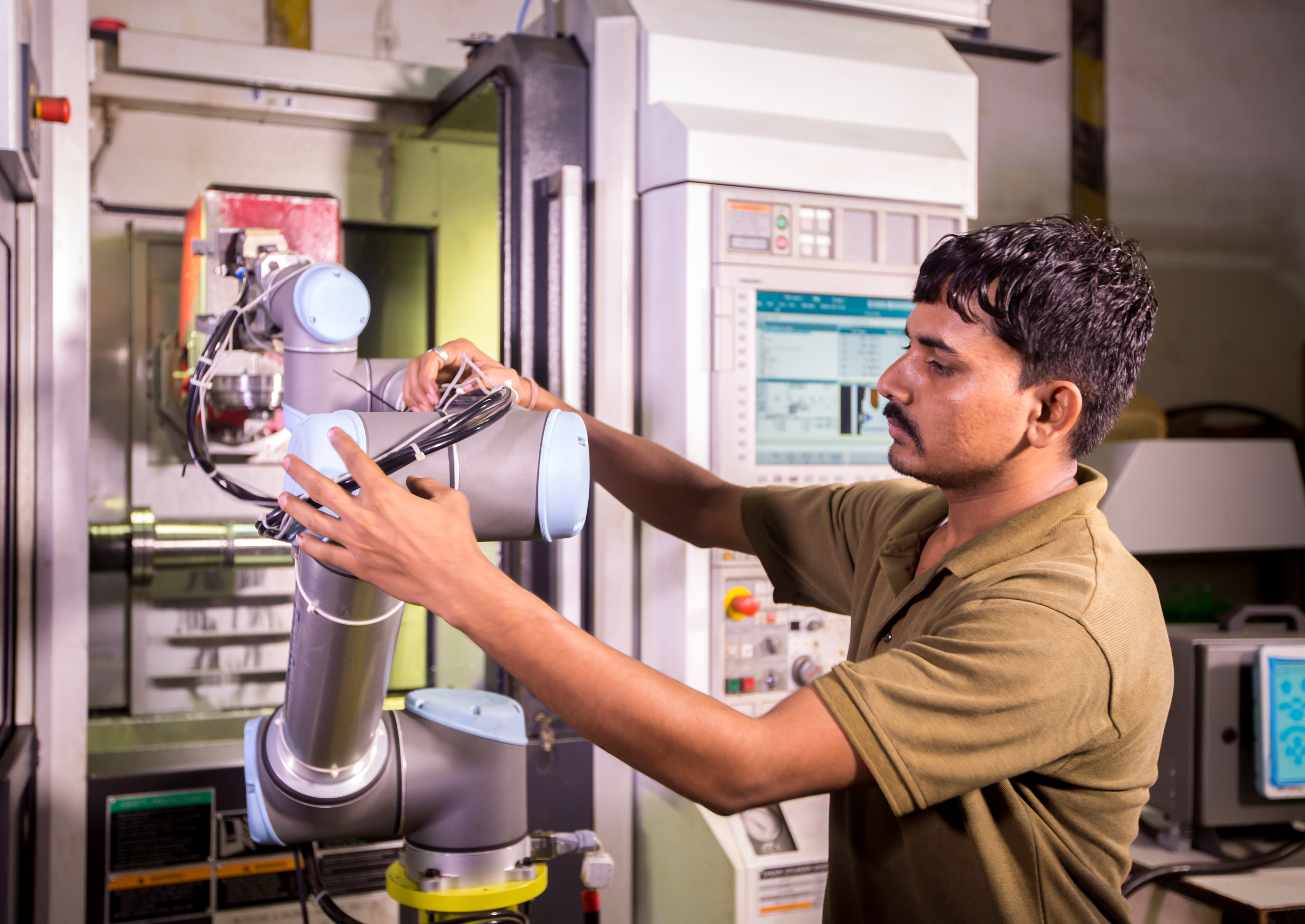 Cobots democratize automation, making it accessible for manufacturers of all sizes. SMEW, Ahmedabad grew from MSME to SME with an ROI of less than 1 year with the help of a single cobot.
Cobots democratize automation, making it accessible for manufacturers of all sizes. SMEW, Ahmedabad grew from MSME to SME with an ROI of less than 1 year with the help of a single cobot.
SMEs are major building blocks in the Indian economy. Given the increased benefits to small manufacturers in India, especially in the COVID-19 economy, cobots are incredibly easy to deploy and manage within the existing environment.
By lowering entry barriers for automation, like space requirements, ease of deployment, and flexible redeployment cobots make it easy for manufacturers of all sizes to take a step in the direction of Industry 4.0, whether they are a multinational, SME, or even an MSME.
Summary
COVID-19 has taken the world by storm. With more than 6 million cases reported globally, the virus is showing no signs of stopping, and there isn't a cure or vaccine in near sight. COVID-19 has ushered in a host of challenges for Indian manufacturing, with many large organizations expecting that this pandemic will have serious financial implications in the coming future. What the Coronavirus has shown us is the unpredictability of life and the need to be prepared for the future.
In starting a whole new chapter, manufacturers need to prepare for a prolonged recovery. Managing human capital and production capabilities becomes of paramount importance. Given the unknown variables of how the COVID-19 pandemic will play out and when containment will be achieved, industrial manufacturers should brace for a trying period and plan for a recovery that may not arrive for at least the next six months. By deploying cobots where suitable, all manufacturers can tide the COVID-19 crisis, in both the short-term as well as the long-term. Cobots offer manufacturers unique solutions that traditional robots cannot provide.
Challenges caused by an acute shortage of labor, changes in assembly lines, and supply and demand level fluctuations can easily be overcome with cobots. The whole world has seen the impact on global supply lines due to their dependence on China. With India being touted as the new destination for global manufacturing, cobots will allow Indian manufacturers to take advantage of this shift and become future-ready.






 Cobots can be used in crowded assembly lines to enable social distancing on the shop floor
Cobots can be used in crowded assembly lines to enable social distancing on the shop floor  Partial automation at Baxter Lab, where an employee opens up boxes while a cobot places products into them
Partial automation at Baxter Lab, where an employee opens up boxes while a cobot places products into them The L'Oréal team flexibly redeploys the cobot to different lines as and when needed
The L'Oréal team flexibly redeploys the cobot to different lines as and when needed Cobots democratize automation, making it accessible for manufacturers of all sizes. SMEW, Ahmedabad grew from MSME to SME with an ROI of less than 1 year with the help of a single cobot.
Cobots democratize automation, making it accessible for manufacturers of all sizes. SMEW, Ahmedabad grew from MSME to SME with an ROI of less than 1 year with the help of a single cobot.